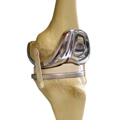(Total Knee Replacement, Knee Joint Replacement, Artificial Knee, Knee Arthroplasty)

An example of an artificial knee.
Knee replacement surgery is performed to reduce pain and improve activity levels caused by a diseased knee joint. It involves replacing a damaged knee joint with an artificial one that is made of metal and plastic and mimics normal knee function (called a prosthesis).
The surgery is commonly done when there is knee joint damage caused by conditions such as osteoarthritis or rheumatoid arthritis, which limit your ability to walk and carry out normal activities.
Knee replacement surgery is performed by an orthopedic surgeon in a hospital.
Risks and precautionsIn general, surgery and the use of anesthesia comes with some risks that are associated with factors like your health and what the surgery involves. Side effects are very rare but can include trouble breathing, reactions to the anesthetic, bleeding, infection, scarring, and death.
Knee replacement is usually a straightforward and safe procedure. However, there are some risks of complications or side effects, including:
- stiffening of the new joint
- nerve damage
- blood clots in the legs or lungs
- heart attack or stroke
It is important that you understand all the risks of complications and side effects of the procedure, and what you or your doctor can do to avoid them. Make sure that your doctor is aware of all your concerns.
Some people may experience complications or side effects other than those listed. Check with your doctor if you notice any symptom that worries you after your procedure.
During the test
- You will be given an anesthetic that will either numb your body below the waist or make you fully unconscious.
- Your leg will be cleaned with an antiseptic solution and you may be given antibiotics through an intravenous (IV) line.
- Your knee will be bent as the orthopedic surgeon makes an incision over the knee joint.
- The damaged joint will be removed and the new prosthesis joint will be inserted.
- The surgeon will then test the joint to make sure it moves well and is stable.
- The incision is then closed with stitches, and a dressing is placed over the surgical wound.
The procedure usually takes about 2 hours and generally requires you to stay in the hospital for a few days.
Before the testIt is important that you fully understand what the procedure involves beforehand. Ask your doctor to explain the risks, benefits, and drawbacks of the procedure, and don't be shy to probe further until you are comfortable with your doctor's responses.
In the weeks leading up to knee replacement surgery, you will meet with the orthopedic surgeon to discuss the surgery and any questions you might have. A preadmission check will be ordered, which may consist of several tests such as X-rays, ultrasounds, electrocardiograms (ECGs), or blood tests.
You may be asked to donate your own blood for use during surgery. You should find out whether you will need to purchase any special equipment before you have the surgery so that you are prepared when you go home.
You may not be able to eat or drink before the procedure; it is important to follow the timing that your doctor recommends, otherwise you run the risk of the surgery being cancelled or postponed. In general, people are advised to not eat for 8 hours before the procedure and most hospitals ask that you do not drink or eat anything after midnight the night before the procedure.
If you are taking any prescription or over-the-counter (non-prescription) medications, supplements, or herbal products, make sure you inform your doctor or pharmacist. Ask them whether it is necessary for you to stop taking any of these medications and products before the procedure. It is also important to tell them if you have allergies to certain medications, bandages, latex, or have other medical conditions.
Plan to have someone drive you home from the hospital. You will also need someone to assist you with daily activities for several weeks after you leave the hospital.
After the testIt is normal to feel these side effects after this procedure:
- pain or discomfort
- limited movement
- fever
- nausea
- swelling in your knee and leg
If you were given general anesthesia before the surgery, you will be assigned to a hospital recovery room immediately after the surgery. As the anesthesia wears off, you may feel sore, groggy, or nauseous. Nurses will be available to assist you.
After the anesthetic wears off, you will be required to stay in the hospital overnight, at which point you will be moved to a regular ward for the rest of your stay. You will stay in the hospital for 3 to 5 days. Before you are discharged, the doctor or nurse will explain the steps you need to take to complete your recovery at home. You will be seen by a physical or occupational therapist who will show you exercises to help with healing and ways to move about safely.
Your surgeon will follow up with you after the surgery to ensure that you are recovering well from the surgery. In general, many people are able to slowly resume most of their activities after 3 to 6 weeks. Full recovery usually takes about 3 months to a year. Ask your doctor about the steps you can take (i.e., physical therapy) to speed up the recovery process.

An example of an artificial knee.